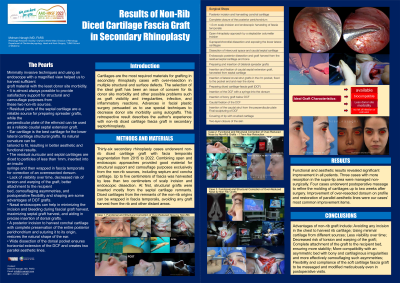Facial Plastic and Reconstructive Surgery
(430) Results of Non-Rib Diced Cartilage Fascia Graft in Secondary Rhinoplasty
Monday, October 2, 2023
2:45 PM - 3:45 PM East Coast USA Time

Has Audio

Mohsen Naraghi, MD, FARS
Triple Board Certified Rhinologist and Facial Plastic Surgeon
RRS
Jacksonville, FL, United States
Presenting Author(s)
Disclosure(s):
Mohsen Naraghi, MD, FARS: No relevant relationships to disclose.
Introduction: The selection of the ideal graft has been an issue of concern for its donor site morbidity and other possible problems such as graft visibility and irregularities, infection, and inflammatory reactions. Advances in facial plastic surgery persuaded us to use special techniques to decrease donor site morbidity using autografts. This retrospective result describes the author's experience with non-rib diced cartilage fascia graft in secondary rhinoplasty.
Methods: Thirty-six secondary rhinoplasty cases underwent non-rib diced cartilage graft with facia temporalis augmentation from 2015 to 2022. Combining open and endoscopic approaches provided good material for structural support and camouflage purposes exclusively from the non-rib sources, including septum and concha cartilage.
Results: Functional and aesthetic results revealed significant improvement in all patients. Three cases with more resorption in the supra-tip area were managed non-surgically. Four cases underwent postoperative massage to refine the molding of cartilages up to two weeks after surgery. Improvement of over-resected dorsum on profile and restoration of parallel aesthetic lines were our cases' most common improvement items.
Conclusions: Non-rib diced cartilage fascia grafts could be a good alternative to rib cartilage grafts. Some advantages of this technique include the following: Avoiding any incision in the chest to harvest rib cartilage; Using minimal cartilage from different sources with the possibility to gather large volume to be wrapped in the fascia; Less visibility over time due to its soft and round edges, visibility of graft edges is more common with solid grafts; Decreased risk of torsion and warping of the graft, a particular concern with rib cartilage grafts; Complete attachment of the graft to the recipient bed, ensuring more stability; More compatibility with an asymmetric bed with bony and cartilaginous irregularities and more effectively camouflaging such asymmetries; Flexibility and compliance of the soft cartilage fascia graft to be massaged and modified meticulously even in postoperative visits.
